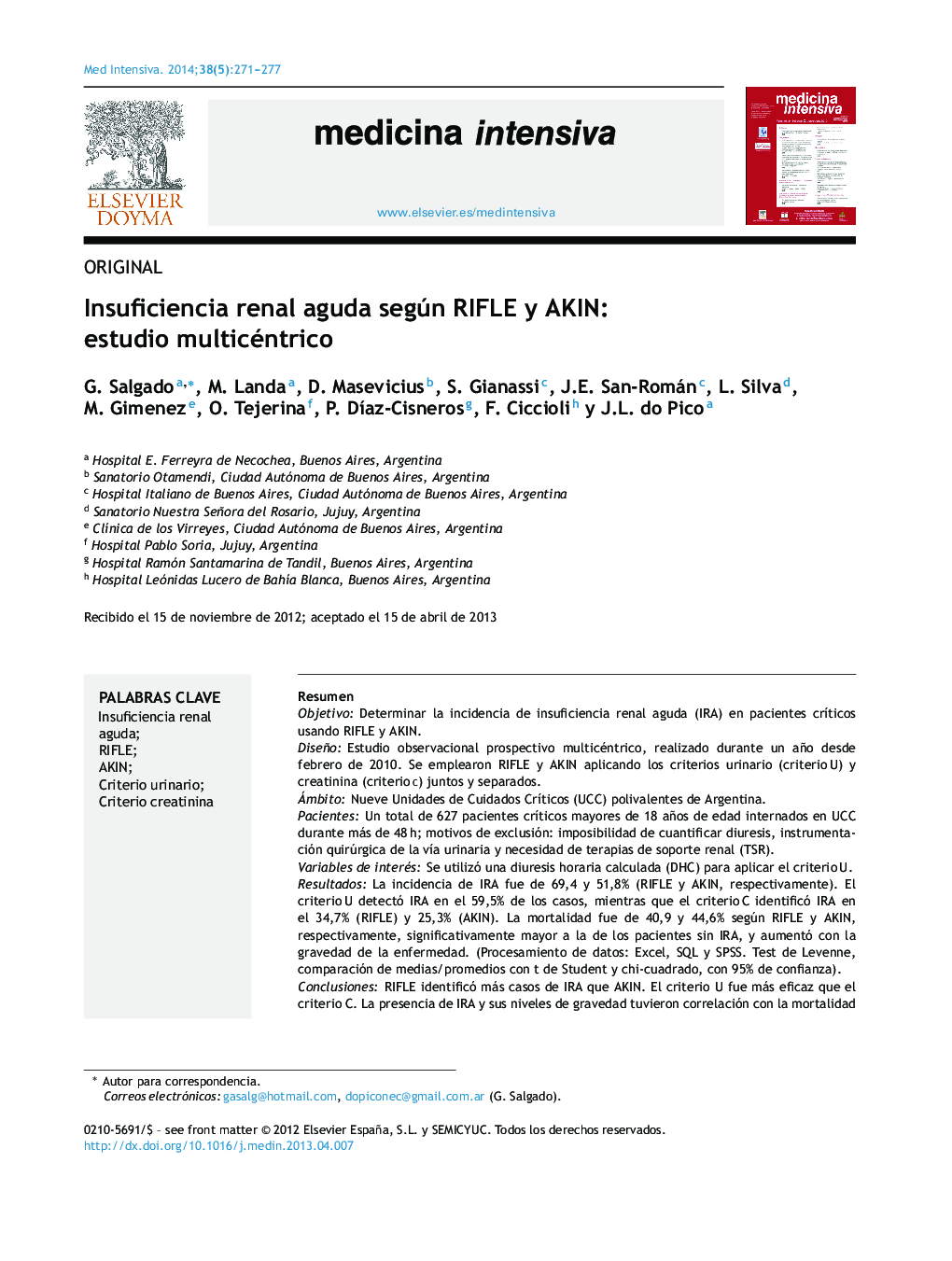| Article ID | Journal | Published Year | Pages | File Type |
|---|---|---|---|---|
| 3112945 | Medicina Intensiva | 2014 | 7 Pages |
ResumenObjetivoDeterminar la incidencia de insuficiencia renal aguda (IRA) en pacientes críticos usando RIFLE y AKIN.DiseñoEstudio observacional prospectivo multicéntrico, realizado durante un año desde febrero de 2010. Se emplearon RIFLE y AKIN aplicando los criterios urinario (criterio U) y creatinina (criterio C) juntos y separados.ÁmbitoNueve Unidades de Cuidados Críticos (UCC) polivalentes de Argentina.PacientesUn total de 627 pacientes críticos mayores de 18 años de edad internados en UCC durante más de 48 h; motivos de exclusión: imposibilidad de cuantificar diuresis, instrumentación quirúrgica de la vía urinaria y necesidad de terapias de soporte renal (TSR).Variables de interésSe utilizó una diuresis horaria calculada (DHC) para aplicar el criterio U.ResultadosLa incidencia de IRA fue de 69,4 y 51,8% (RIFLE y AKIN, respectivamente). El criterio U detectó IRA en el 59,5% de los casos, mientras que el criterio C identificó IRA en el 34,7% (RIFLE) y 25,3% (AKIN). La mortalidad fue de 40,9 y 44,6% según RIFLE y AKIN, respectivamente, significativamente mayor a la de los pacientes sin IRA, y aumentó con la gravedad de la enfermedad. (Procesamiento de datos: Excel, SQL y SPSS. Test de Levenne, comparación de medias/promedios con t de Student y chi-cuadrado, con 95% de confianza).ConclusionesRIFLE identificó más casos de IRA que AKIN. El criterio U fue más eficaz que el criterio C. La presencia de IRA y sus niveles de gravedad tuvieron correlación con la mortalidad pero no con los días de estancia en UCC. La implementación de la DHC fue útil para unificar la aplicación del criterio C y lograr resultados comparables.
ObjectiveTo determine the incidence of acute renal failure (ARF) in critically ill patients using the RIFLE and AKIN criteria.DesignA prospective, multicenter observational study with a duration of one year from February 2010 was carried out. RIFLE and AKIN were employed using the urinary (UC) and creatinine criteria (CC) jointly and separately.ScopeNine polyvalent Critical Care Units (CCUs) in Argentina.PatientsA total of 627 critical patients over 18 years of age were admitted to the CCU for more than 48 h. Exclusion criteria: inability to quantify diuresis, surgical instrumentation of the urinary tract, and need for renal support therapy (RST).Variables of interestCalculated hourly diuresis (CHD) was used to apply the UC.ResultsThe incidence of ARF was 69.4% and 51.8% according to RIFLE and AKIN, respectively. UC detected ARF in 59.5% of cases, while CC identified ARF in 34.7% (RIFLE) and 25.3% (AKIN). The mortality rate was 40.9% and 44.6% according to RIFLE and AKIN respectively, was significantly higher than in patients without ARF, and increased with disease severity (Data processing: Excel, SQL and SPSS. Levene test, comparison of means with Student t and chi-squared, with 95% confidence interval).ConclusionsRIFLE identified more cases of ARF. UC proved more effective than CC. The presence of ARF and severity levels were correlated to mortality but not to days of stay in the CCU. Implementation of the unified CHD was useful for implementing UC and achieving comparable results.
